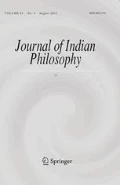Abstract
The pūrvapakṣa of the Śūnyavāda chapter of Kumārila’s Ślokavārttika (vv. 10-63) is the longest continuous statement of a Buddhist position in that work. Philosophically, this section is of considerable interest in that the arguments developed for the thesis that the form (ākāra) in cognition belongs to the cognition, not to an external object, are cleverly constructed. Historically, it is of interest in that it represents a stage of thinking about the two-fold nature of cognition and the provenance of the ākāra that is clearly more advanced than Dignāga but not quite as sophisticated as Dharmakīrti. In particular, although one may see an anticipation of Dharmakīrti’s famous sahopalambhaniyama argument in this text, it is not yet fully spelled out.
Similar content being viewed by others
References
Primary Sources
Kāś.: Kāśikā of Sucaritamiśra. See ŚV(T).
NR: Nyāyaratnākara of Pārthasārathimiśra. See ŚV(B).
PV(I): Sāṅkṛtyāyana, R. (Ed.). (1938). Pramāṇavārttikam by Ācārya Dharmakīrti. Journal of the Bihar and Orissa Research Society, 24, Appendix.
PV(Tib.): Miyasaka, Y. (Ed.). (1971–1972). Pramāṇavārttika-kārikā (Sanskrit and Tibetan). Acta Indologica, 2, 1–206.
PVBh(k): Sāṅkṛtyāyana, R. (Ed.). (1953). Pramāṇavārtikabhāshyam or Vārtikālaṇkāraḥ of Prajñākaragupta (Being a commentary on Dharmakīrti’s Pramāṇavārtikam). Patna: Kashi Prasad Jayaswal Research Institute.
PVV(k): Sāṅkṛtyāyana, R. (Ed.). (1938–1940). Dharmakīrti’s Pramāṇavārttika with a Commentary by Manorathanandin. Journal of the Bihar and Orissa Research Society, 24–26, Appendix.
PVin: Steinkellner, E. (Ed.). (2007). Dharmakīrti’s Pramāṇaviniścaya, Chapters 1 and 2. Beijing/ Vienna: China Tibetology Publishing House/ Austrian Academy of Sciences Press. For Corrigenda, cf. Wiener Zeitschrift für die Kunde Südasiens 51 (2007–2008) 207–208, as well as http://ikga.oeaw.ac.at/Mat/steinkellner07_corrigenda.pdf (last accessed 28 June 2010).
PS: Steinkellner, E. (Ed.). (2010). Dignāga’s Pramāṇasamuccaya, Chapter 1. A hypothetical reconstruction with the help of the two Tibetan translations on the basis of the hitherto known Sanskrit fragments and the linguistic materials gained from Jinendrabuddhi’s Ṭīkā. URL: http://ikga.oeaw.ac.at/Mat/dignaga_PS_1.pdf (last accessed 28 June 2010).
BSBh: Śāstri, A., & Paṇsikar, V.L.S. (Eds.). (1982). Brahmasūtra Śāṇkara Bhāshya, with the commentaries Bhāmati, Kalpataru and Parimala. Varanasi: Krishnadas Academy.
Vaidalyaprakaraṇa: Tola, F. & Dragonetti, C. (Eds., trans.). (1995). Nāgārjuna’s refutation of logic (Nyāya): Vaidalyaprakaraṇa. Delhi: Motilal Banarsidass.
ŚBh: Frauwallner, E. (Ed.). (1968). Śabarasvāmi’s Bhāṣyam zu den Mīmāṃsāsūtren I.1,1-5. In Erich Frauwallner, Materialien zur ältesten Erkenntnislehre der Karmamīmāṃsā (pp. 7–61). Wien: Österreichische Akademie der Wissenschaften.
ŚV(T): Sāstrī, K. S. (Ed.). (1926, 1929). Mīmāṃsā Slokavārtika with the commentary Kasika of Sucaritamiśra. Trivandrum (reprint Trivandrum: CBH Publications 1990).
ŚV(B): Śāstrī, D. (Ed.). (1978). Ślokavārttika of Śrī Kumārila Bhaṭṭa, with the commentary Nyāyaratnākara of Śrī Pārthasārathimiśra. Varanasi: Tara Publications.
ŚV(M): Sastri, S. K. R. (Ed.). (1971). Revised by K. K. Raja and R. Thangaswamy. Ślokvavārtikavyākhyā Tātparyaṭīkā of Uṃveka Bhaṭṭa. Madras: University of Madras.
ŚVVT: Ślokvavārtikavyākhyātātparyaṭīkā of Umbekabhaṭṭa. See ŚV(M).
Secondary Sources
Hanneder J. (2007) Vasubandhu’s Viṃśatikā 1 2 anhand der Sanskrit- und tibetischen Fassungen. In: Klaus K., Hartmann J.-U. (eds) Indica et Tibetica. Festschrift für Michael Hahn, zum 65. Geburtstag von Freunden und Schülern überreicht. Wien, Arbeitskreis für Tibetische und Buddhistische Studien, pp 207–214
Harada W. (2003) A philological and doctrinal reconsideration of the Viṃśatikā Vijñaptimātratāsiddhiḥ, Part 3. Bulletin of Kyushu Ryukoku Junior College, 49: 131–188 (in Japanese)
Iwata T. (1991) Sahopalambhaniyama: Struktur und Entwicklung des Schlusses von der Tatsache, daß Erkenntnis und Gegenstand ausschließlich zusammen wahrgenommen werden, auf deren Nichtverschiedenheit. 2 Volumes. Franz Steiner, Stuttgart
Kano K. (2008) Two short glosses on Yogācāra texts by Vairocanarakṣita: Viṃśikāṭikāvivṛti and *Dharmadharmatāvibhāgavivṛti. In: Sferra F. (eds) Sanskrit texts from Giuseppe Tucci’s collection, Part I. Istituto Italiano per L’Africa e L’Oriente, Roma, pp 343–380
Kellner, B. (forthcoming). Infinite regress arguments (anavasthā) in connection with self-awareness (svasaṃvedana): A closer look at Dignāga and Dharmakīrti. Paper presented at 14th World Sanskrit Conference, Kyōto. Journal of Indian Philosophy (to appear).
Kellner, B. (2009–2010). Towards a critical edition of Dharmakīrti’s Pramāṇavārttika. In J. Hanneder & P. A. Maas. (Eds.), Text genealogy, textual criticism and editorial technique = Wiener Zeitschrift für die Kunde Südasiens, 52–53, 161–211.
Kripke S. (1972) Naming and necessity. Harvard University Press, Cambridge, MA
Moore G.E. (1922) Philosophical studies. Routledge and Kegan Paul, London
Taber, J. (1986–1992). Further observations on Kumārila’s Bṛhaṭṭīkā. Journal of Oriental Research, 56–62, 179–189.
Taber J. (2005) A Hindu critique of Buddhist Epistemology. Kumārila on perception The “Determination of Perception” chapter of Kumārila Bhaṭṭa’s Ślokavārttika. Translation and Commentary. RoutledgeCurzon, London/New York
Author information
Authors and Affiliations
Corresponding author
Rights and permissions
About this article
Cite this article
Taber, J. Kumārila’s Buddhist. J Indian Philos 38, 279–296 (2010). https://doi.org/10.1007/s10781-010-9093-9
Published:
Issue Date:
DOI: https://doi.org/10.1007/s10781-010-9093-9




